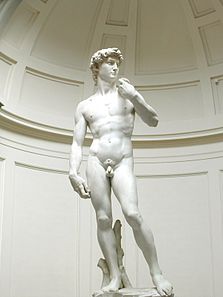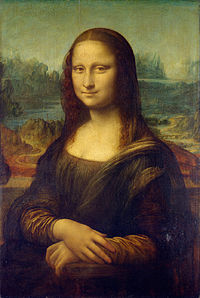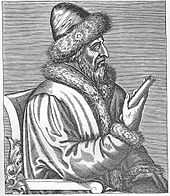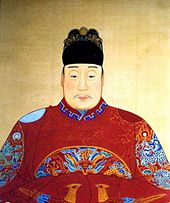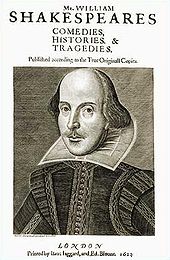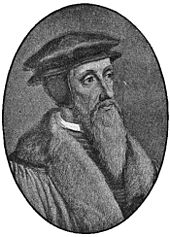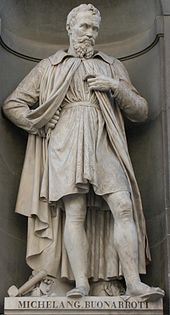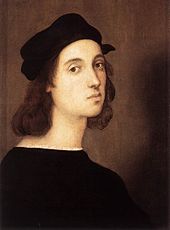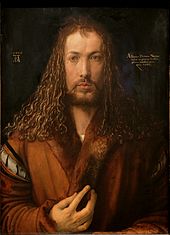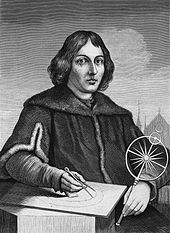
16th century
About this schools Wikipedia selection
The articles in this Schools selection have been arranged by curriculum topic thanks to SOS Children volunteers. Visit the SOS Children website at http://www.soschildren.org/
| Millennium: | 2nd millennium |
|---|---|
| Centuries: |
|
| Decades: | 1500s 1510s 1520s 1530s 1540s 1550s 1560s 1570s 1580s 1590s |
| Categories: | Births – Deaths Establishments – Disestablishments |
| Millennium: | 2nd millennium |
|---|---|
| Centuries: |
|
| Decades: | 1500s 1510s 1520s 1530s 1540s 1550s 1560s 1570s 1580s 1590s |
| Categories: | Births – Deaths Establishments – Disestablishments |
The 16th century begins with the Julian year 1501 and ends with either the Julian or the Gregorian year 1600 (depending on the reckoning used; the Gregorian calendar introduced a lapse of 10 days in October 1582).
It is regarded by historians as the century in which the rise of the West occurred. During the 16th century, Spain and Portugal explored the world's seas and opened world-wide oceanic trade routes. Large parts of the New World became Spanish and Portuguese colonies, and while the Portuguese became the masters of Asia's and Africa's Indian Ocean trade, the Spanish opened trade across the Pacific Ocean, linking the Americas with Asia.
In Europe, the Protestant Reformation gave a major blow to the authority of the Papacy and the Roman Catholic Church. European politics became dominated by religious conflicts, with the groundwork for the epochal Thirty Years' War being laid towards the end of the century.
In the Middle East, the Ottoman Empire continued to expand, with the Sultan taking the title of Caliph, while dealing with a resurgent Persia. Iran and Iraq were caught by major popularity of the once-obscure Shiite sect of Islam under the rule of the Safavid dynasty of warrior-mystics, providing grounds for a Persia independent of the majority- Sunni Muslim world.
China evacuated the coastal areas, because of Japanese piracy. Japan was suffering under a severe civil war at the time.
Mughal Emperor Akbar extended the power of the Mughal Empire to cover most of the Indian sub continent. His rule significantly influenced arts, and culture in the region.
Copernicus proposed the heliocentric universe, which was met with strong resistance, and Tycho Brahe refuted the theory of celestial spheres through observational measurement of the 1572 appearance of a Milky Way Super Nova. These events directly challenged the long-held notion of an immutable universe supported by Ptolemy and Aristotle, and led to major revolutions in astronomy and science.
Events
Undated
- Polybius' "The Histories" translated into Italian, English, German and French.
- Mississippian culture disappears.
- Medallion rug, variant Star Ushak style, Anatolia (modern Turkey), is made. It is now kept at The Saint Louis Art Museum.
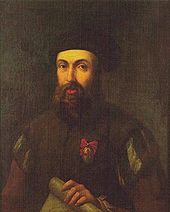
1500s
- 1500: Guru Nanak The beginning and spreading of the 5th largest Religion in the World Sikhism.
- 1500: Spanish navigator Vicente Yáñez Pinzón encounters Brazil but is prevented from claiming it by the Treaty of Tordesillas.
- 1500: Portuguese navigator Pedro Álvares Cabral claims Brazil for Portugal.
- 1500: The Ottoman fleet of Kemal Reis defeats the Venetians at the Second Battle of Lepanto.
- 1501: Michelangelo returns to his native Florence to begin work on the statue David.
- 1501: Safavid dynasty reunified Iran and ruled over it until 1736. Safavids adopt a Shia branch of Islam.
- 1502: First reported African slaves in The New World
- 1503: Foundation of the Sultanate of Sennar by Amara Dunqas, in what is modern Sudan
- 1503: Spain defeats France at the Battle of Cerignola. Considered to be the first battle in history won by gunpowder small arms.
- 1503: Leonardo da Vinci begins painting the Mona Lisa and completes it three or four years later.
- 1503: Nostradamus was born on either December 14, or December 21.
- 1504: A period of drought, with famine in all of Spain.
- 1505: Zhengde Emperor ascended the throne of Ming Dynasty.
- 1506: King Afonso I of Kongo wins the battle of Mbanza Kongo, resulting in Catholicism becoming Kongo's state religion.
- 1506: At least two thousand converted Jews are massacred in a Lisbon riot.
- 1506: Christopher Columbus dies in Valladolid, Spain.
- 1506: Poland is invaded by Tatars from the Crimean Khanate.
- 1507: The first recorded epidemic of smallpox in the New World occurs on the island of Hispaniola and decimates the native Taíno population.
- 1509: The Battle of Diu marks the beginning of Portuguese dominance of the Spice trade.
1510s
- 1509– 10: The 'great plague' afflicts various parts of Tudor England.
- 1511: Afonso de Albuquerque of Portugal conquers Malacca, the capital of the Sultanate of Malacca.
- 1512: Copernicus writes Commentariolus, and moves the sun to the centre of the solar system.
- 1512: The southern part (historical core) of the Kingdom of Navarre is invaded by Castile and Aragon.
- 1513: Machiavelli writes The Prince, a treatise about political philosophy
- 1513: The Portuguese mariner Jorge Álvares lands at Macau, China, during the Ming Dynasty.
- 1513: Henry VIII crush the French at the Battle of the Spurs.
- 1513: The Battle of Flodden Field in which invading Scots are defeated by Henry VIII's forces.
- 1513: Sultan Selim I ("The Grim") orders the massacre of Shia Muslims in Anatolia.
- 1513: Vasco Núñez de Balboa, in service of Spain arrives at the Pacific Ocean (which he called Mar del Sur) across the Isthmus of Panama. He was the first European to do so.
- 1514: The Battle of Orsha halts Muscovy's expansion into Eastern Europe.
- 1514: The Battle of Chaldiran, the Ottoman Empire gains decisive victory against Safavid dynasty.
- 1515: The Ottoman Empire wrests Eastern Anatolia from the Safavids after the Battle of Chaldiran.
- 1516– 17: The Ottomans defeat the Mamluks and gain control of Egypt, Arabia, and the Levant.
- 1517: The Sweating sickness epidemic hits Tudor England.
- 1517: The Protestant Reformation begins when Martin Luther posts his 95 Theses in Saxony.
- 1518: Mir Chakar Khan Rind leaves Baluchistan and settled in Punjab.
- 1519: Leonardo da Vinci dies of natural causes at May 2.
- 1519: Wang Yangming, the Chinese philosopher and governor of Jiangxi province, describes his intent to use the firepower of the fo-lang-ji, a breech-loading Portuguese culverin, in order to suppress the rebellion of Prince Zhu Chen-hao.
- 1519: Barbary pirates led by Hayreddin Barbarossa raid Provence and Toulon in southern France.
- 1519: Charles I of Spain becomes Emperor of Holy Roman Empire as Charles V, Holy Roman Emperor (ruled until 1556).
- 1519– 22: Spanish expedition commanded by Magellan and Elcano first to circle Earth
- 1519– 21: Hernán Cortés leads the Spanish conquest of Mexico.
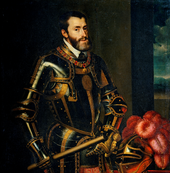
1520s
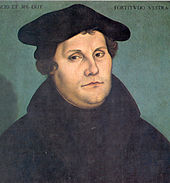
- 1520– 1566: The reign of Suleiman the Magnificent marks the zenith of the Ottoman Empire.
- 1520: The first European diplomatic mission to Ethiopia, sent by the Portuguese, arrives at Massawa 9 April, and reaches the imperial encampment of Emperor Dawit II in Shewa 9 October.
- 1520: The Yousafzais defeat Dilazaks at the battle of Katlang to found the Yousafzai dynasty in Pakhtunkhwa in modern day Pakistan and Afghanistan.
- 1521: Belgrade is captured by the Ottoman Empire.
- 1521: After building fortifications at Tuen Mun, the Portuguese attempt to invade Ming Dynasty China, but are expelled by Chinese naval forces.
- 1521: Philippines encountered by Ferdinand Magellan. He was later killed in battle in central Philippines in the same year.
- 1521: Jiajing Emperor ascended the throne of Ming Dynasty.
- 1522: Rhodes falls to the Ottoman Turks of Suleiman the Magnificent.
- 1523: Sweden gains independence from the Kalmar Union.
- 1524– 25: German Peasants' War in the Holy Roman Empire.
- 1524 – Giovanni da Verrazzano is the first European to explore the Atlantic coast of North America between South Carolina and Newfoundland.
- 1524 - Ismail I, the founder of Safavid dynasty, dead and Tahmasp I became king.
- 1525: Spain and Germany defeat France at the Battle of Pavia, Francis I of France is captured.
- 1526: The Ottomans defeat the Kingdom of Hungary at the Battle of Mohács.
- 1526: Mughal Empire, founded by Babur, rules India until 1857.
- 1527: Sack of Rome, which is considered the end of the Italian Renaissance.
- 1527: Protestant Reformation begins in Sweden.
- 1529: The Austrians defeat the Ottoman Empire at the Siege of Vienna.
- 1529: Treaty of Zaragoza defined the antimeridian of Tordesillas attributing the Moluccas to Portugal and Philippines to Spain.
- 1529: Imam Ahmad Gragn defeats the Ethiopian Emperor Dawit II in the Battle of Shimbra Kure, the opening clash of the Ethiopian–Adal War
1530s
- 1531– 32: The Church of England breaks away from the Roman Catholic Church and recognizes King Henry VIII as the head of the Church.
- 1531: The Inca Civil War is fought between the two brothers, Atahualpa and Huáscar.
- 1532: Francisco Pizarro leads the Spanish conquest of the Inca Empire.
- 1533: Anne Boleyn becomes Queen of England.
- 1533: Elizabeth Tudor is born.
- 1534: Jacques Cartier claims Quebec for France.
- 1534: The Ottomans capture Baghdad.
- 1534: Affair of the Placards – Francis becomes more active in repression of French Protestants.
- 1535: The Münster Rebellion, an attempt of radical, millennialist, Anabaptists to establish a theocracy ends in bloodshed.
- 1536: Katherine of Aragon dies in Kimbolton Castle.
- 1536: Anne Boleyn is beheaded for adultery and treason.
- 1536: Establishment of the Inquisition in Portugal
- 1536: Foundation of Buenos Aires by Pedro de Mendoza
- 1537: Portuguese establishes Recife in Pernambuco, north-east of Brazil.
- 1537: William Tyndale's partial translation of the Bible into English is published, which would eventually be incorporated into the King James Bible.
- 1538: Gonzalo Jiménez de Quesada founds Bogotá.
- 1538: Spanish– Venetian fleet is defeated by the Ottoman Turks at the Battle of Preveza.
- 1539: Hernando de Soto explores inland North America.
1540s
- 1540: Sher Shah Suri founds Suri dynasty in South Asia, an ethnic Pashtun (Pathan) of the house of Sur, who supplanted the Mughal dynasty as rulers of North India during the reign of the relatively ineffectual second Mughal emperor Humayun. Sher Shah decisively defeats Central Asian invader Humayun in the Battle of Bilgram (May 17, 1540).
- 1541: Pedro de Valdivia founds Santiago de Chile.
- 1541: An Algerian military campaign by Charles V of Spain ( Habsburg) is unsuccessful.
- 1541: Amazon River is encountered and explored by Francisco de Orellana.
- 1541: Capture of Buda and the absorption of the major part of Hungary by the Ottoman Empire.
- 1541: Sahib I Giray of Crimea invade Russia.
- 1542: War resumes between Francis I of France and Emperor Charles V. This time Henry VIII is allied to the Emperor, while James V of Scotland and Sultan Suleiman I are allied to the French.
- 1542: Spanish explorer Ruy López de Villalobos named the island of Samar and Leyte Las Islas Filipinas honoring Philip II of Spain and became the official name of the archipelago.
- 1543: Ethiopian/Portuguese troops decisively defeat the Muslim army at the Battle of Wayna Daga; Imam Ahmad Gragn killed.
- 1543: The Nanban trade period begins after Portuguese traders make contact with Japan.
- 1544: The French defeat an Imperial–Spanish army at the Battle of Ceresole.
- 1544: Battle of the Shirts in Scotland. The Frasers and Macdonalds of Clan Ranald fight over a disputed chiefship; reportedly, 5 Frasers and 8 Macdonalds survive.
- 1545: Songhai forces sack the Malian capital of Niani
- 1545: The Council of Trent meets for the first time in Trent.
- 1546: Michelangelo Buonarroti is made chief architect of St. Peter's Basilica.
- 1547: Henry VIII dies in the Palace of Whitehall on 28 January at the age of 55.
- 1547: Edward VI becomes King of England and Ireland on 28 January and is crowned on 20 February at the age of 9.
- 1547: Emperor Charles V decisively dismantles the Schmalkaldic League at the Battle of Mühlberg.
- 1547: Grand Prince Ivan the Terrible is crowned tsar of (All)Russia, thenceforth becoming the first Russian tsar.
- 1548: Battle of Uedahara: Firearms are used for the first time on the battlefield in Japan, and Takeda Shingen is defeated by Murakami Yoshikiyo.
- 1548: The Ming Dynasty government of China issues a decree banning all foreign trade and closes down all seaports along the coast; these Hai jin laws came during the Wokou wars with Japanese pirates.
- 1549: Tomé de Souza establishes Salvador in Bahia, north-east of Brazil.
1550s


- 1550: Mongols led by Altan Khan invade China and besiege Beijing.
- 1550– 1551: Valladolid debate concerning the existence of souls in Amerindians
- 1551: Fifth outbreak of sweating sickness in England. John Caius of Shrewsbury writes the first full contemporary account of the symptoms of the disease.
- 1551: North African pirates enslave the entire population of the Maltese island Gozo, between 5,000 and 6,000, sending them to Libya.
- 1552: Russia conquers the Khanate of Kazan.
- 1553: Mary Tudor becomes the first queen regnant of England and restores the Church of England under Papal authority.
- 1553: Portuguese found a settlement at Macau.
- 1554: Portuguese missionaries José de Anchieta and Manuel da Nóbrega establishes São Paulo, southeast Brazil.
- 1555: The Muscovy Company is the first major English joint stock trading company.
- 1556: Publication in Venice of Delle Navigiationi et Viaggi (terzo volume) by Giovanni Battista Ramusio, secretary of Council of Ten, with plan La Terra de Hochelaga, an illustration of the Hochelaga.
- 1556: The Shaanxi Earthquake in China is history's deadliest known earthquake.
- 1556: Georgius Agricola, the "Father of Mineralogy", publishes his De re metallica.
- 1556: Akbar the Great defeats the Sultan of Bengal at the Second battle of Panipat
- 1556: Russia conquers the Astrakhan Khanate.
- 1556– 1605: During his reign, Akbar expands the Mughal Empire in a series of conquests.
- 1556: Mir Chakar Khan Rind captured Delhi with Emperor Humayun.
- 1556: Pomponio Algerio, radical theologian, is executed by boiling in oil as part of the Roman inquisition.
- 1557: Due to high debts, Habsburg Spain declares bankruptcy. Philip II of Spain had to declare four state bankruptcies in 1557, 1560, 1575 and 1596.
- 1557: The Portuguese settle in Macau.
- 1557: The Ottomans capture Massawa, all but isolating Ethiopia from the rest of the world.
- 1558 Elizabeth Tudor becomes Queen Elizabeth I at age 25.
- 1558– 1603: The Elizabethan era is considered the height of the English Renaissance.
- 1558– 83: Livonian War between Poland, Grand Principality of Lithuania, Sweden, Denmark and Russia.
- 1558: After 200 years, the Kingdom of England loses Calais to France.
- 1559: With the Peace of Cateau Cambrésis, the Italian Wars conclude.
1560s

- 1560: Ottoman navy defeats the Spanish fleet at the Battle of Djerba.
- 1560: Erzsebet Bathory is born in Nyirbator, Hungary.
- 1560: By winning the Battle of Okehazama, Oda Nobunaga becomes one of the pre-eminent warlords of Japan
- 1561: Sir Francis Bacon is born in London.
- 1561: Guido de Bres draws up the Belgic Confession of Protestant faith.
- 1562: Mughal leader Akbar reconciles the Muslim and Hindu factions by marrying into the powerful Rajput Hindu caste.
- 1562– 98: French Wars of Religion between Catholics and Huguenots.
- 1562: Massacre of Wassy and Battle of Dreux in the French Wars of Religion.
- 1563: Plague outbreak claimed 80,000 people in Elizabethan England. In London alone, over 20,000 people died of the disease.
- 1564: Galileo Galilei born on February 15
- 1564: William Shakespeare baptized 26 April
- 1565: Battle of Talikota fought between the Hindu kingdom of Vijayanagar and the Deccan sultanates.
- 1565: Mir Chakar Khan Rind died age of 97.
- 1565: Estácio de Sá establishes Rio de Janeiro in Brazil.
- 1565: The Hospitallers defeat the Ottoman Empire at the Siege of Malta (1565).
- 1565: Miguel López de Legazpi establishes in Cebu the first Spanish settlement in the Philippines starting a period of Spanish colonization that would last over three hundred years.
- 1565: Spanish navigator Andres de Urdaneta discovers the maritime route from Asia to the Americas across the Pacific Ocean, also known as the tornaviaje.
- 1566– 1648: Eighty Years' War between Spain and the Netherlands.
- 1567: After 45 years' reign, Jiajing Emperor died in the Forbidden City, Longqing Emperor ascended the throne of Ming Dynasty.
- 1567: Mary, Queen of Scots, is imprisoned by Elizabeth I.
- 1568– 1571: Morisco Revolt in Spain.
- 1568– 1600: The Azuchi-Momoyama period in Japan.
- 1569: Rising of the North in England.
- 1569: The Polish–Lithuanian Commonwealth is created with the Union of Lublin which lasts until 1795.
1570s
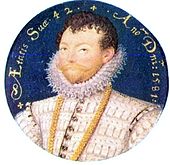
- 1570: Ivan the Terrible orders the massacre of inhabitants of Novgorod.
- 1570: Pope Pius V issues Papal bull Regnans in Excelsis excommunicating all who obeyed Elizabeth I and calling on all Roman Catholics to rebel against her.
- 1571: Pope Pius V completes the Holy League as a united front against the Ottoman Turks.
- 1571: The Spanish-led Holy League navy destroys the Ottoman Empire navy at the Battle of Lepanto.
- 1571: Crimean Tatars attack and sack Moscow, burning everything but the Kremlin.
- 1571: American Indians kill Spanish missionaries in what would later be Jamestown, Virginia.
- 1571: Spanish conquistador Miguel López de Legazpi establishes Manila, Philippines as the capital of the Spanish East Indies.
- 1572: Brielle is taken from Habsburg Spain by Protestant Watergeuzen in the Capture of Brielle, in the Eighty Years' War.
- 1572: Spanish conquistadores apprehend the last Inca leader Tupak Amaru at Vilcabamba, Peru, and execute him in Cuzco.
- 1572: Catherine de' Medici instigates the St. Bartholomew's Day massacre which takes the lives of Protestant leader Gaspard de Coligny and thousands of Huguenots. The violence spreads from Paris to other cities and the countryside.
- 1572: First edition of the epic The Lusiads of Luís Vaz de Camões, three years after the author returned from the East.
- 1572: The 9 years old Taizi, Zhu Yijun ascended the throne of Ming Dynasty, known as Wanli Emperor.
- 1573: After heavy losses on both sides the Siege of Haarlem ends in a Spanish victory.
- 1574: in the Eighty Years' War the capital of Zeeland, Middelburg declares for the Protestants.
- 1574: After a siege of 4 months the Siege of Leiden ends in a comprehensive Dutch rebel victory.
- 1575: Oda Nobunaga finally captures Nagashima fortress.
- 1576: Tahmasp I, Safavid king, died.
- 1576: Sack of Antwerp by badly paid Spanish soldiers.
- 1577– 80: Francis Drake circles the world.
- 1578: King Sebastian of Portugal is killed at the Battle of Alcazarquivir.
- 1579: The Union of Utrecht unifies the northern Netherlands, a foundation for the later Dutch Republic.
- 1579: The Union of Arras unifies the southern Netherlands, a foundation for the later states of the Spanish Netherlands, the Austrian Netherlands and Belgium
1580s

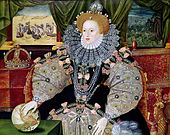
- 1580: Drake's royal reception after his attacks on Spanish possessions influences Philip II of Spain to build up the Spanish Armada. English ships in Spanish harbours are impounded.
- 1580: Spain unifies with Portugal under Philip II. The struggle for the throne of Portugal ends the Portuguese Empire. The Spanish and Portuguese crowns are united for 60 years, i.e. until 1640.
- 1582: Oda Nobunaga is assassinated by his general, Akechi Mitsuhide.
- 1582: Pope Gregory XIII issues the Gregorian calendar. The last day of the Julian calendar was Thursday, 4 October 1582 and this was followed by the first day of the Gregorian calendar, Friday, 15 October 1582
- 1582: Yermak Timofeyevich conquers the Siberia Khanate on behalf of the Stroganovs.
- 1584– 85: After the Siege of Antwerp, many of its merchants flee to Amsterdam. According to Luc-Normand Tellier, "At its peak, between 1510 and 1557, Antwerp concentrated about 40% of the world trade...It is estimated that the port of Antwerp was earning the Spanish crown seven times more revenues than the Americas."
- 1585 : Colony at Roanoke founded in North America
- 1585– 1604: The Anglo-Spanish War is fought on both sides of the Atlantic.
- 1587 - The reign of Abbas I marks the zenith of the Safavid dynasty.
- 1588: England repulses the Spanish Armada.
- 1589: Spain repulses the English Armada.
1590s
- 1590: Siege of Odawara the Go-Hojo clan surrendered to Toyotomi Hideyoshi, and Japan was unified (1590).
- 1591: Gazi Giray leads a huge Tatar expedition against Moscow.
- 1591: In Mali, Moroccan forces of the Sultan Ahmad al-Mansur led by Judar Pasha defeat the Songhai Empire at the Battle of Tondibi.
- 1592– 1593: John Stow reports 10,675 plague deaths in London, a city of approximately 200,000 people.
- 1592– 98: Korea, with the help of Ming Dynasty China, repels two Japanese invasions.
- 1593– 1606: The Long War between the Habsburg monarchy and the Ottoman Turks.
- 1596: Birth of René Descartes.
- 1598: The Edict of Nantes ends the French Wars of Religion.
- 1598: Abbas I moved Safavids capital from Qazvin to Isfahan in 1598.
- 1598– 1613: Russia descends into anarchy during the Time of Troubles.
- 1599: The Mali Empire is defeated at the Battle of Jenné
- 1600: Giordano Bruno is burned at the stake for heresy in Rome.
- 1600: Battle of Sekigahara in Japan. End of the Warring States period and beginning of the Edo period.
Significant people

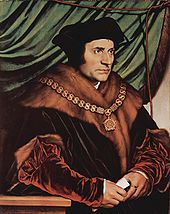

- Leonardo da Vinci, famous artist and inventor and scientist ( 1452 – 1519).
- Henry VII of England, founder of the Tudor dynasty. Introduced ruthlessly efficient mechanisms of taxation which restored the kingdom after a state of virtual bankruptcy due to the effects of the Wars of the Roses ( 1457 – 1509).
- Ismail I ( 1487- 1524) reunified Persia, established Safavid dynasty and declared Shia Islam as the state religion.
- Desiderius Erasmus Roterodamus (sometimes known as Desiderius Erasmus of Rotterdam) (October 27, 1466/1469, Rotterdam– July 12, 1536 Basel was a Dutch Renaissance humanist and Catholic Christian theologian.
- Zygmunt I the Old, King of Poland, established a conscription army and the bureaucracy needed to finance it ( 1467 – 1548).
- György Dózsa, leader of the peasants' revolt in Hungary ( 1470 – 1514)
- Michelangelo Buonarroti, Italian painter and sculptor ( 1475 – 1564).
- Raphael, Italian painter, ( 1483 – 1520)
- Martin Luther, German religious reformer ( 1483 – 1546).
- Giovanni Battista Ramusio (20 July 1485 – 10 July 1557), diplomat and secretary of council of Ten of Venice Italy, author of Delle Navigationi et Viaggi. Third volume (terzo volume) containing plan "La Terra de Hochelaga" showing the village of Hochelaga.
- King Henry VIII of England, founder of Anglicanism ( 1491 – 1547).
- Anne Boleyn, second wife of King Henry VIII. She was the first Queen of England to be executed, and the mother of Queen Elizabeth I. (c. 1501 - 1536)
- William Shakespeare, 1564–1616) was an English poet and playwright, widely regarded as the greatest writer in the English language and the world's pre-eminent dramatist. He is often called England's national poet and the "Bard of Avon".
- Ignatius of Loyola, founder of the Society of Jesus ( 1491 – 1556).
- Paracelsus (11 November or 17 December 1493 in Einsiedeln, Switzerland – 24 September 1541 in Salzburg, Austria), Renaissance physician, botanist, alchemist, astrologer, and general occultist.
- King Francis I of France, considered the first Renaissance monarch of his Kingdom ( 1494 – 1547).
- Suleiman the Magnificent, Sultan of the Ottoman Empire. Conqueror and legal reformer ( 1494 – 1566).
- Abbas I, the strongest king of Safavid dynasty ( 1571- 1629).
- King Gustav I of Sweden, restored Swedish sovereignty and introduced Protestantism in Sweden ( 1496– 1560).
- Charles V, Holy Roman Emperor and the first to reign as King of Spain. Involved in almost constant conflict with France and the Ottoman Empire while promoting the Spanish colonization of the Americas ( 1500 – 1558).
- Cuauhtémoc, the last Tlatoani of the Aztec, led the native resistance against the Conquistadores ( 1502 – 1525).
- Michel Nostradamus, French astrologer and doctor, author of Les Propheties, a book of world prophecies ( 1503 – 1566).
- Ahmad ibn Ibrihim al-Ghazi, Somali Imam and general ( 1507 – 1543).
- Andrea Palladio (November 30, 1508 – August 19, 1580), one of the most influential architect of the Western architecture
- John Calvin, theologian, and reformer. Founder of Calvinism ( 1509 – 1564).
- Manus Ó Domhnaill (Manus O'Donnell), King of Tír Chonaill in Ulster. Irish Renaissance prince (died 1564).
- Andreas Vesalius, anatomist, physician, and author of one of the most influential books on human anatomy, De humani corporis fabrica (On the Workings of the Human Body).(1514–1564)
- Mary I of England. Attempted to counter the Protestant Reformation in her domains. Nicknamed Bloody Mary for her Religious persecution ( 1516 – 1558).
- Andrea Amati, (c. 1520 – c. 1578) was the earliest maker of violins whose instruments still survive today.
- John Knox (c. 1510 – 1572) was a Scottish clergyman and leader of the Protestant Reformation who is considered the founder of the Presbyterian denomination.
- King Philip II of Spain. It was first said of his empire that "the sun did not set". Strong defender of Catholicism and self-proclaimed leader of Counter-Reformation ( 1527 – 1598).
- Ivan IV of Russia, first Russian tsar ( 1533– 1584).
- William the Silent, William I of Orange-Nassau, main leader of the Dutch revolt against the Spanish ( 1533– 1584).
- Elizabeth I of England, central figure of the Elizabethan era ( 1533 – 1603). She was the granddaughter of the aforementioned Henry VII, daughter of Henry VIII and paternal half-sister of Mary I. Though some within her court thought of her merely as a bastard, because her father executed her supposedly criminal mother Anne Boleyn, her reign is still considered one of the greatest ever in England's history.
- Oda Nobunaga, daimyo of the Sengoku period of Japanese civil war. First ruler of the Azuchi-Momoyama period ( 1534 – 1582).
- Toyotomi Hideyoshi, daimyo of the Sengoku period of Japanese civil war. Second ruler of the Azuchi-Momoyama period ( 1536 – 1598).
- Edward VI of England, notable for further differentiating Anglicanism from the practices of the Roman Catholic Church ( 1537 – 1553).
- Lady Jane Grey, Queen regnant of England and Ireland. Notably deposed by popular revolt ( 1537 – 1554).
- Mary, Queen of Scots, First female head of the House of Stuart ( 1542 – 1587).
- Akbar the Great, third Mughal emperor, who led the Mughal Empire to its zenith ( 1542 – 1605)
- Johan van Oldenbarnevelt, Dutch politician and Grand Pensionary, played a pivotal role in organizing the Dutch revolt against Spain ( 1542 – 1619).
- Admiral Yi Sun-sin, Korean admiral, respected as one of the greatest admirals in world history. ( 1545 – 1598).
- Matteo Ricci, Italian Jesuit who traveled to Macau, China in 1582, and died in Beijing, ( 1552 – 1610)
- King Henry IV of France and Navarre, ended the French Wars of Religion and reunited the kingdom under his command ( 1553 – 1610).
- Michael the Brave, ruler of Walachia, national symbol of Romanians for uniting the three provinces under his rule in 1600 ( 1558 – 1601)
- Wanli Emperor, Emperor of China during the Ming Dynasty, aided Korea in the Imjin War, ( 1563 – 1620)
- Sigismund III Vasa, the first and only monarch of the Polish–Swedish union; his long reign in the Polish–Lithuanian Commonwealth coincided with the apex of the Commonwealth's prestige, power and economic influence ( 1566 – 1632).
Exploration
- Vasco Núñez de Balboa (c. 1475–1519) – Spanish explorer. The first European to cross the Isthmus of Panama and view the Pacific ocean from American shores.
- Pedro Álvares Cabral, Portuguese navigator. The first European to arrive in Brazil in 22 April 1500 (c. 1467 – 1520).
- Jacques Cartier (1491–1557) – French explorer. Discovered Canada.
- Francisco Vásquez de Coronado (c. 1510–1554) – Spanish explorer. Searched for the Seven Cities of Gold and discovered the Grand Canyon in the process
- Hernán Cortés, Spanish Conquistador ( 1485 – 1547).
- Andrés de Urdaneta (c. 1498-1568) was a Spanish navigator, friar and circumnavigator. In 1565 he discovered the maritime path from Asia to the Americas across the Pacific.
- Sir Francis Drake (c. 1540–1596) – English explorer. The first English captain to sail around the world and survive.
- Juan Sebastián Elcano (1476–1526) – Spanish explorer. Completed the first circumnavigation of the globe in a single expedition after its captain, Magellan, was killed.
- Vasco da Gama, Portuguese navigator. The first one to sail around the Cape of Good Hope (c. 1469 – 1524).
- Juan Ponce de León (c. 1460–1521) – Spanish explorer. He explored Florida while attempting to locate a Fountain of Youth.
- Ferdinand Magellan, Portuguese navigator who sailed around the world ( 1480 – 1521).
- Francisco de Orellana (1511–1546) – Spanish explorer in 1541– 42 sails the length of the Amazon River.
- Francisco Pizarro (c. 1475–1541) – Spanish explorer and conquistador. Conquered the Inca Empire.
- Hernando de Soto (c. 1496–1542) – Spanish explorer. Explored Florida, mainly northwest Florida, and discovered the Mississippi River.
- Yermak Timofeyevich (c. 1532–1585) - Russian cossack ataman. Conquered the Khanate of Siberia
- Luis Váez de Torres (c. 1565–1607) Spanish or Portuguese navigator. Explored the Pacific for the Spanish crown and crossed the strait that bears his name in northern Australia.
- Giovanni da Verrazzano (c. 1485–1528) – Italian explorer for France. Explored the northeast coast of America, from about present day South Carolina to Newfoundland.
Visual artists
- Michelangelo Buonarroti, Italian painter and sculptor ( 1475 – 1564).
- Caravaggio, Italian artist ( 1571 – 1610).
- Albrecht Dürer, German artist, ( 1471 – 1528)
- Hans Holbein the Younger, German artist, ( 1497 – 1543)
- Raphael, Italian painter, ( 1483 – 1520)
- Donato Bramante (1444 – March 11, 1514)
- Titian, Italian painter, (c. 1485 – 1576)
- Paolo Veronese, Italian painter, ( 1528 – April 19, 1588)
- Leonardo da Vinci famous artist and inventor and scientist ( 1452 – 1519).
- Qiu Ying, Chinese painter who belonged to the Wu School and used gongbi brush style ( 1494 – 1552)
- Pieter Bruegel the Elder, (c. 1525 – September 9, 1569)
- Jan Brueghel the Elder (1568 – January 13, 1625)
- Tintoretto (real name Jacopo Comin; September 29, 1518 – May 31, 1594)
- Lucas Cranach the Elder (1472–1553)
- Lucas Cranach the Younger (1515–1586)
- El Greco (1541 – April 7, 1614) was a painter, sculptor, and architect of the Spanish Renaissance
- Mimar Sinan (1489–1588) was a civil engineer and chief architect of the Ottoman Empire
- Juan de Herrera, Spanish architect ( 1530- 1597)
- Domenico Fontana (1543 – June 28, 1607) was an architect
Musicians and Composers
- Andrea Amati (c. 1520 – c. 1578)
- Felice Anerio (c. 1560–1614)
- Adriano Banchieri (c. 1557–1634)
- Giovanni Bassano (c. 1558–1617)
- William Brade (1560–1630)
- John Bull (c. 1562–1628)
- Antonio de Cabezón (c. 1510–1566)
- Giulio Caccini (c. 1545–1618)
- Dario Castello (c. 1560–c. 1640)
- Emilio de' Cavalieri (c. 1550–March 11, 1602)
- Jacques Champion (before 1555–1642)
- Manuel Rodrigues Coelho (c. 1555–c. 1635)
- John Dowland (1563–1626)
- Giles Farnaby (1565–1640)
- Alfonso Fontanelli (1557–1622)
- Hans Leo Hassler (1562–1612)
- Sebastian Aguilera de Heredia (1565–1627)
- Joseph Lupo
- Peter Lupo (c. 1535-1608)
- Thomas Lupo (c. 1571-c. 1627)
- Ascanio Mayone (1565–1627)
- Cristóbal de Morales (c. 1500–1553)
- Giovanni Bernardino Nanino (c. 1560–1623)
- Johannes Nucius (c. 1556–1620)
- Giovanni Pierluigi da Palestrina, ( 1525– 1594)
- Jacopo Peri (1561–1633)
- Peter Philips (c. 1560–1628)
- Hieronymus Praetorius (1560–1629)
- Paolo Quagliati (c. 1555–1628)
- Francisco de Salinas (1513-1590)
- Jan Pieterszoon Sweelinck (1562–1621)
- Jean Titelouze (1563–1633)
- Lodovico Grossi da Viadana (1564–1627)
- Tomás Luis de Victoria (1548–1611)
Literature
- Juan Martínez de Jáuregui y Aguilar, Spanish poet and painter, ( 1483 – 1541)
- Teresa of Ávila,Spanish mystic and poet, ( 1515 - 1582).
- Luís de Camões, Portuguese poet (c. 1524 – 1580).
- Baldassare Castiglione, Italian author ( 1478 – 1529)
- Miguel de Cervantes, Spanish author ( 1547 – 1616).
- John of the Cross, Spanish mystic and poet, ( 1542 - 1591)
- John Donne, English metaphysical poet ( 1572 – 1631)
- John Ford, English dramatist ( 1586 – c. 1640).
- Thomas Heywood, English dramatist (c, early 1570s – 1641)
- Ben Jonson, English dramatist (c. 1572 – 1637)
- Jan Kochanowski, Polish poet ( 1530 – 1584)
- Fuzûlî, Azerbaijani poet ( 1483 – 1556)
- Thomas Kyd, English dramatist ( 1558 – 1594)
- Luis de León, Spanish poet ( 1527 - 1591)
- Thomas Lodge, English dramatist ( 1558 – 1625)
- Niccolò Machiavelli, Italian author ( 1469 – 1527)
- Christopher Marlowe, English poet and dramatist ( 1564 – 1593).
- Michel de Montaigne, French essayist ( 1533 – 1592).
- Thomas More, English politician and author ( 1478 – 1535).
- Miyamoto Musashi, famous warrior in Japan, author of The Book of Five Rings, a treaty on strategy and martial combat. ( 1584 – 1645)
- François Rabelais, French author (c. 1493 – 1553).
- Mikołaj Rej, Polish writer ( 1505 – 1569).
- Pierre de Ronsard, French poet. Called the 'Prince of poets' of his generation. ( 1524 – 1585).
- William Shakespeare, English playwright ( 1564 – 1616).
- Edmund Spenser, English poet (c. 1552 – 1599)
- Bâkî, Ottoman Turkish poet. He was known as "Sultan of poets" ( 1526 – 1600)
- Garcilaso de la Vega, Spanish poet ( 1501 - 1536)
- Lope de Vega, Spanish dramatist ( 1562 – 1635).
Science and Philosophy
- Mulla Sadra, ( 1571- 1641), the single most important and influential philosopher in the Muslim world in the last four hundred years who introduced Transcendent Theosophy or al-hikmah al-muta'liyah .
- Sir Francis Bacon, ( 1561 – 1626) was an English philosopher, statesman, and essayist. He is also known as a catalyst of the scientific revolution.
- Tycho Brahe, ( 1546 – 1601), Danish astronomer.
- Giordano Bruno, Italian philosopher and astronomer/astrologer ( 1548 – 1600).
- Nicolaus Copernicus, ( 1473 – 1543) astronomer, developed the heliocentric (Sun-centered) theory using scientific methods.
- Galileo Galilei ( 1564 – 1642) was a Tuscan ( Italian) physicist, mathematician, astronomer, and philosopher who played a major role in the scientific revolution.
- Konrad Gessner ( 1516 – 1565) was a Swiss naturalist, bibliographer, Botanist, His three-volume Historiae animalium (1551–1558) is considered the beginning of modern zoology
- William Gilbert, also known as Gilberd, ( 1544 – 1603) was an English physician and a natural philosopher.
- Johannes Kepler, ( 1571 - 1630), mathematician, astronomer, and philosopher who played a major role in the scientific revolution.
- Gerardus Mercator (5 March 1512 – 2 December 1594), famous cartographer
- Emery Molyneux (died June 1598), was an Elizabethan maker of globes, mathematical instruments and ordnance. His terrestrial and celestial globes, first published in 1592, were the first to be made in England and the first to be made by an Englishman.
- Andreas Vesalius (Brussels, December 31, 1514 – Zakynthos, October 15, 1564) was an anatomist, physician, and author of one of the most influential books on human anatomy, De humani corporis fabrica (On the Workings of the Human Body). Vesalius is often referred to as the founder of modern human anatomy.
- Edward Wright, (baptized 1561; died 1615), English mathematician and cartographer who determined the mathematical basis of the Mercator projection and produced the first maps in England according to this method
Inventions, discoveries, introductions
- Related article: List of 16th century inventions.
- The Columbian Exchange introduces many plants, animals and diseases to the Old and New Worlds.
- Introduction of the spinning wheel revolutionizes textile production in Europe.
- The letter J is introduced into the English alphabet.
- 1500: First portable watch is created by Peter Henlein of Germany.
- 1513: Juan Ponce de León sights Florida and Vasco Núñez de Balboa sights the eastern edge of the Pacific Ocean.
- 1519– 22: Ferdinand Magellan and Juan Sebastián Elcano lead the first circumnavigation of the World.
- 1519– 1540: In America, Hernando de Soto expeditions map the Gulf of Mexico coastline and bays.
- 1525: Modern square root symbol (√)
- 1540: Francisco Vásquez de Coronado sights the Grand Canyon.
- 1541– 42: Francisco de Orellana sails the length of the Amazon River.
- 1543: Copernicus publishes his theory that the Earth and the other planets revolve around the Sun
- 1545: Theory of complex numbers is first developed by Gerolamo Cardamo of Italy.
- 1558: Camera obscura is first used in Europe by Giambattista della Porta of Italy.
- 1559– 1562: Spanish settlements in Alabama/Florida and Georgia confirm dangers of hurricanes and local native warring tribes.
- 1565: Spanish settlers outside New Spain (Mexico) colonize Florida's coastline at St. Augustine.
- 1565: Invention of the graphite pencil (in a wooden holder) by Conrad Gesner. Modernized in 1812.
- 1568: Gerardus Mercator creates the first Mercator Projection map.
- 1572: Supernova SN 1572 is observed by Tycho Brahe in the Milky Way.
- 1582: Gregorian calendar is introduced in Europe by Pope Gregory XIII and adopted by catholic countries.
- c. 1583: Galileo Galilei of Pisa, Italy identifies the constant swing of a pendulum, leading to development of reliable timekeepers.
- 1585: earliest known reference to the ' sailing carriage' in China.
- 1589: William Lee invents the stocking frame.
- 1591: First flush toilet is introduced by Sir John Harrington of England, the design published under the title 'The Metamorphosis of Ajax'.
- 1593: Galileo Galilei invents a thermometer.
- 1596: William Barents discovers Spitsbergen.
- 1597: Opera in Florence by Jacopo Peri.
Decades and years
|
|||||||||||||||||||||||||||||||||||||||||||||||||||||||||||||||||||||||||||||||||||||||||||||||||||||||||||||||||||||||||||||||||||||||||
|
|||||||||||||||||||||||||||||||||||||||||||||||||||||||||||||||||||||||||||||||||||||||||||||||||||||||||||||||||||


